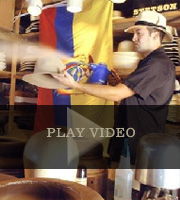Hatmaker specializes in custom work, styles. He molds hats by hand and employs scarce weavers in Ecuador.
ST. AUGUSTINE – In order to spin new life into an old hat, all it takes is an iron, some steam – and years of long-lost training, according to one retailer.
Tony Lippi, a St. Augustine hatmaker and retailer, is trying to keep the art of molding the perfect fedora by hand – not machine – alive with his shop, the Panama Hat Co. Since taking over the St. George Street storefront from his parents in 2002, Lippi has made it his mission to do custom hat manufacturing the old-fashioned way, as well as using independent weavers in Ecuador for some of the more coveted, handmade designs.
“We are very specialized in those hard-to-find styles,” Lippi said. “There are very few weavers left that make the hats we sell.”
Using heated elements such as an iron and steam, Lippi can transform an existing hat into an entirely different shape or style using wooden molds called “blocks.” Lippi has four to five dozen of these – mostly antiques culled on eBay or defunct manufacturers – in his shop.
“Blocking is all about reshaping and customizing, taking an old hat and making a new hat,” he said. “If you brought me a fedora, I could steam iron it into anything.”
With his tools, he can smooth the knifelike creases in a gambler-style fedora into the smooth dome of a derby hat, “just like a jeweler does for all its clients.”
He similarly customized several hats for the trombone player in Conan O’Brien’s late night show house band, who often complained that his trombone knocked into his hats’ brims. Lippi crafted a “trombone-proof” model.
Not all the hats in Lippi’s shop are molded by him.
The most expensive hat sold is called a Montecristi Super Fino – a particular style from Ecuador that is hand-woven from straw – and can fetch up to $2,000.
The hats appear as though they are made from crisp linen but are actually composed of tightly braided straw.
Anthony Hopkins wore one in Silence of the Lambs, and Jeff Bridges donned one in Seabiscuit. Only a scant number of weavers in the world are able to make them, Lippi said.
“We’re trying to keep the art alive by keeping the few weavers interested,” he said. “We are willing to pay enough to make it worth their while.”
It takes four months to make a single one, which accounts for the price tag, Lippi said.
The Ecuadorean family he employs to make the hats weaves only a dozen a year, which explains why he doesn’t sell them online.
“We don’t have the supply to keep up with the demand,” he said.
That demand is being stoked by the influx of celebrities getting creative with their head gear – not to mention the boosted awareness of skin and sun damage.
“A short brim fedora is cool with the MTV as well as a Cuban guy playing chess in the park – not everyone can rock a Godfather-style derby,” he said. “So many people buy ball caps – but those do nothing for their necks or ears.”
diana.middleton@jacksonville.com,
(904) 359-4404

